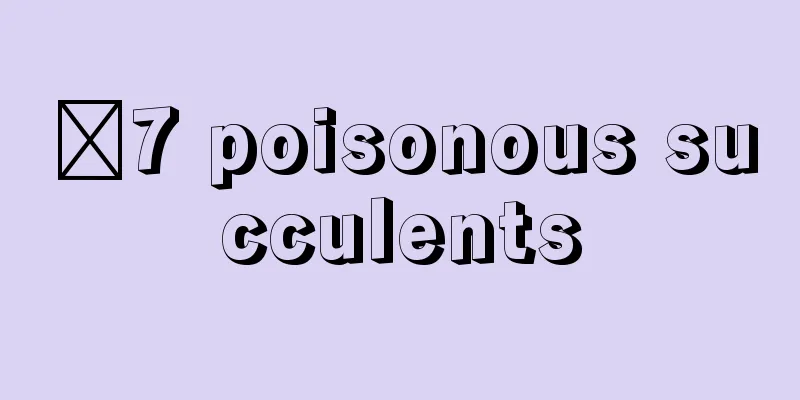7 poisonous succulents

|
Nowadays, more and more vendors are selling succulents in the streets and alleys. Because succulents are cute in appearance and easy to grow, they are very popular among many boys and girls. Moreover, as a kind of green plant, succulents can be placed indoors and undergo photosynthesis. It can evolve air very well, but some succulents are poisonous. Now let me introduce to you which are the poisonous succulents in No. 7 Middle School. The Crassulaceae, also known as the Jade Tree, is shameless and should be familiar to everyone. It is a succulent plant of the Crassulaceae family. The juice is poisonous. If the juice splashes into the eyes, rinse immediately with clean water and seek medical attention in time, otherwise it may cause blindness. Euphorbia pilosa is a succulent plant of the Euphorbiaceae family. It has thorny branches and blooms in summer, and its leaves fall off in winter. The body contains toxins, the juice is milky white, and it will cause itching if it comes into contact with the skin. Dragon bone is a large succulent plant variety, which can reach a height of 5 meters. It is easy to divide and has small leaves. It belongs to the Euphorbiaceae family Euphorbia genus succulent plant. It should be specially mentioned here that most of the succulents in the Euphorbiaceae family are poisonous. I will not give examples one by one. Here I will only list some common ones for you. Euphorbia grandis, a succulent plant of the genus Euphorbia in the Euphorbiaceae family, is also a large succulent plant with relatively thin leaves, which will fall off in the winter in the north. The weeping angel, also known as calla lily, has two types on the market. One is the large-leaf calla lily, which can grow several meters high, and the other is the small-leaf calla lily, which can only grow to about one meter at most. Both are highly toxic and can cause spasms and convulsions if ingested by mistake. It is recommended that families with children do not raise them. The Chinese parviflora grows in tropical and subtropical regions and is native to East Africa and South Africa. Its body is relatively smooth, hairless and thornless. Baimacheng is a succulent plant of the genus Apocynaceae. All succulents in the Apocynaceae family are poisonous, and the toxicity is quite strong, which can cause cardiac arrest, so it is better not to grow this plant. Afang Palace is fleshy all over, and belongs to the genus Qifengjin. Both the branches and leaves are poisonous. The juice will cause redness and swelling if it splashes into the eyes. However, the toxicity is relatively low, so as long as it does not get in contact with the eyes, it will not cause much harm to the human body. White-horned Euphorbia is also a succulent plant of the genus Euphorbia. It has moderate toxicity and its juice should not be allowed to come into contact with wounds. If the thorns prick the skin, it will cause a burning pain. Qunyan, a small succulent plant, the plant is relatively short, the maximum does not exceed 30 cm, it is a mini succulent plant Kylin Palm, also known as Jade Kylin, is named after its similarity to the ancient mythical beast Kylin. It is a tropical succulent plant native to South Africa. The leaves of the love vine are heart-shaped, and its flower language is love that spreads endlessly. Do you know that there is sadness behind sweet love, which is poison? The love vine is a succulent plant of the genus Asteraceae. Newleaf Hoya, a climbing succulent plant of the same family and genus as the love vine. It emits a liquid at night that is irritating to patients with chronic diseases and asthma, so it is not suitable for indoor cultivation. Qinglongjiao, a succulent plant of the genus Momordica in the Apocynaceae family, has a relatively small plant shape, has relatively high temperature requirements, and is not easy to grow Desert rose, belonging to the genus Desertrose of the Apocynaceae family, likes high temperature environments and its flowers are very beautiful. Daffodils are very fragrant when they bloom in winter. They must be thrown away promptly after flowering. The tubers underneath are highly toxic. Children and pregnant women must not be allowed to come into contact with them, as this will cause poisoning. |
<<: Why do we still plant oleander if it is poisonous
>>: Ranking of 27 venomous snakes in China
Recommend
How to treat benign nasopharyngeal carcinoma
How to treat benign nasopharyngeal carcinoma? 1. ...
What to use to ripen bananas
As a common fruit, many friends prefer to eat ban...
Can't sleep because of the snoring
When you can't sleep because of loud snoring,...
Can I get eyelash extensions when I am pregnant? Can I get eyelash extensions when I am pregnant?
We all know that women should try to avoid contac...
The efficacy and function of pomegranate shell
The whole pomegranate is a treasure. The seeds of...
How to remove black mildew from clothes?
In daily life, if clothes are not properly preser...
Can olive oil be used to massage breasts?
Women are most concerned about their skin conditi...
Psychological distress and adjustment in the workplace
The workplace is known as a battlefield without t...
What are the symptoms of advanced peripheral lung cancer? Four symptoms of advanced peripheral lung cancer that you should know
Early diagnosis of peripheral lung cancer is very...
Can I eat apricots when I have a fever?
Fever is a common disease. Many people have had f...
What tea is effective for moistening the intestines and relieving constipation?
Due to overeating and other improper eating habit...
How to eat strawberry jam five ways to eat recommended
Strawberry jam is delicious and nutritious, but m...
Is surgery meaningful for advanced colon cancer?
Is surgery meaningful for advanced colon cancer? ...
Is malignant cervical cancer contagious?
Is cervical cancer contagious? This is a question...
What is the reason for the foul smell of urine
Many people know that by looking at the urine you...









